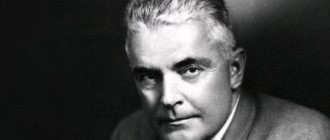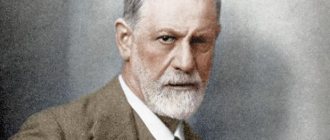Behaviorism is a psychological theory based on human behavior, which is a set of reactions to various stimuli from the outside. The birth date of the concept is considered to be 1913, when its founder, J. Walter, published the first article on psychology from the point of view of a behaviorist. Representatives of the theory interpret learning as the basis of human development, and consider the behavior of humans and animals as the subject of psychology. They conducted many experiments that showed the possibility of learning one or another behavioral strategy. However, many of them were carried out on animals, and the conclusions extended to humans. Since behaviorists did not highlight any special differences between the behavior of animals and humans.
Founder of the behavioral approach
J. Watson is considered the founder of behaviorism. He called his goal the reconstruction of psychology as a science into a more accurate and objective one, which provides a qualitative and quantitative assessment of the properties of the psyche. He also created the fundamental scheme for learning behavior, which is the subject of study in behaviorism: a stimulus causes a response. That is, he said that the behavior of any person depends only on what stimuli he encounters and how he reacts to them. In addition, he was confident that using this scheme, any baby could be raised into the kind of person who would be most in demand in society.
Research by Pavlov and Thorndike
I.P. Pavlova, one might say, was the predecessor of the theory of behaviorism, since on the basis of his theory of reflexes the concept of behavior was created. He worked with animals and found out that they have certain unconditioned reflexes, embedded in the form of instincts and determining the behavior of the creature. He also revealed the possibility of artificially developing conditioned reflexes, on the basis of which the behavior of the animal as a whole is built.
E. Thorndike believed that the starting point for the formation of a reaction is not just an external stimulus, but a problematic situation that causes discomfort or pleasure in a person. It forces him to move in the right direction and perform the necessary actions to get rid of discomfort or obtain pleasant sensations. If the stimulus does not evoke either positive or negative emotions in the individual, then the reaction may not follow. Thorndike's views significantly complemented the theory of behaviorism, but his ideas were excluded from the classical concept, since its founders could not allow scientists to take into account the subjective and physiological characteristics of the individual when studying humans.
B. Skinner's research within the framework of behaviorism
Burress Skinner is an American psychologist, writer, successor of the ideas of J. Watson, who developed the theory of operant conditioning .
He believed that the human body is a “black box.” Everything that fills this box (emotions, motives, drives) cannot be objectively measured, so they should be excluded from the sphere of empirical observation. But behavior can be objectively measured, in fact, this is what Skinner did.
He did not accept the idea of a personality that directs or stimulates behavior. Skinner believed that behavior is generated not by forces that are inside a person (for example, traits, needs, thoughts, feelings), but by forces that lie outside a person. This means that human behavior is regulated not from the inside, but from the outside (by the environment). The study of personality according to Skinner is the discovery of the peculiar nature of the relationship between the behavior of an organism and the results of this behavior, which subsequently reinforce it. This approach focuses on predicting and controlling observed behavior.
B. Skinner, like J. Watson, was interested in such a phenomenon as learning. He even developed the concept of operant conditioning, which was based on the law of effect, which was discovered by E. Thorndike.
Operant conditioning is a learning method that involves a system of rewards and punishments to increase or stop a particular type of behavior. In this case, the body associates its behavior with the subsequent result. Such learning is aimed at reinforcing behavior controlled by the individual.
For example, a person is trying to teach a dog to follow a command. When the dog successfully copes (i.e. follows the command), it receives encouragement (praise, treat). When a dog fails to complete a task, it does not receive reinforcement. As a result, the dog establishes a connection between a certain behavior and the opportunity to receive a reward. In a similar way, you can wean your dog, for example, from doing “its business” on the carpet. You just have to use a punishment system (for example, scold the dog). It turns out to be a kind of “carrot and stick” method. On this occasion, I advise you to read the most interesting book by Karen Pryor , which is called “Don’t growl at the dog! A book about training people, animals and yourself."
Skinner conducted experiments on hungry animals (rats, pigeons), which he placed in a box, which was called the “Skinner box”. The box was empty, there was only a protruding lever inside, under which stood a plate for food. Left alone in the box, the rat moves around and explores it. At some point, the rat discovers a lever and presses it. After establishing the background level (the frequency with which the rat initially presses the lever), the experimenter triggers a food cassette located outside the box. When the rat presses the lever, a small ball of food falls into the plate. The rat eats it and soon presses the lever again. Food reinforces pressing the lever, and the frequency of pressing increases. If the food cassette is disconnected so that pressing the lever no longer delivers food, the frequency of pressing will decrease.
Thus, Skinner noticed that an operantly conditioned response, when not reinforced, fades in exactly the same way as a classically conditioned response. The researcher can establish a differentiation criterion by presenting food only when the rat presses a lever while the light is on, thereby conditioning the rat through selective reinforcement. Light here serves as a stimulus that controls the reaction.
Skinner also adds provisions for two types of behavior: respondent and operant behavior. Response behavior is a characteristic response evoked by a known stimulus; the stimulus, in this case, always precedes the reaction. Examples include constriction or dilation of the pupil in response to light stimulation, jerking of the knee when hitting the patellar tendon with a hammer, and shivering when cold. Operant behavior is a voluntary learned response for which there is no recognizable stimulus. Evoked by operant conditioning, this behavior is determined by the events that follow the response. Those. behavior is followed by a consequence, and the nature of that consequence changes the organism's tendency to repeat that behavior in the future. For example, roller skating, playing the guitar, and writing one's name are operant response patterns (or operants) controlled by the outcomes that follow the corresponding behavior.
The essence of the approach
The essence of the behavioral approach is to study and shape human behavior through various stimuli. They can be determined by the environment - an example from life - the experience of a “hungry” time makes a person overly thrifty; or be artificial - for example, an experiment with little Albert, who was artificially made to be afraid of everything white and fluffy. In addition, stimuli can be both physically tangible - extreme heat or cold, physical punishment, frequent hugs; and verbal, coming from the environment - censure or praise. Subjective experiences - emotions, feelings, states - are not denied in behaviorism, but it is believed that they only depend on external influences, and are not determined by them.
Report with a presentation for a speech at a seminar on the topic: “Behaviorism.”
Slide number 2
Definition of behaviorism.
The definition of this term can be found in many dictionaries and encyclopedias. Such sources may be:
- Philosophy:
Encyclopedic Dictionary . - M. _ : Gardariki . Edited by A. _ A . Ivina . 2004 . Philosophical Encyclopedic Dictionary . - M. _ : Soviet Encyclopedia . Ch . editor : L. F. _ Ilyichev , P. _ N. _ Fedoseev , S. _ M. _ Kovalev , V. _ G . Panov . 1983 . - Philosophical
Encyclopedic Dictionary . 2010 . - Philosophical
Encyclopedia . In 5 - x t . - M. _ : Soviet Encyclopedia . Edited by F. _ IN . Konstantinov . 1960 - 1970 . - New
Philosophical Encyclopedia: In 4 vols
.
M.
_
: Thought
.
Edited by V.
_
WITH
.
Stepina
.
2001
.
Spelling dictionary-reference book. - Great psychological encyclopedia.
- Political science. Dictionary.
- Encyclopedia of cultural studies.
- Dictionary of foreign words of the Russian language.
- Dictionary of business terms.
- Modern encyclopedia.
- Big Encyclopedic Dictionary.
- Economic Dictionary.
- Psychological Dictionary.
Slide number 3
Analysis of these sources shows that the term BEHAVIORISM is of English origin (behavior), which means behavior. Denotes the leading trend in psychology of the late 19th and early 20th centuries, which arose against the backdrop of the accelerated growth of industrial production in Europe and became especially widespread in America. The development of this direction best met the needs of developing socio-economic relations in the context of the emergence of new industrial powers. In this light, behaviorism can also be viewed as a theory of the psychological foundations of behavior, relating, in particular, to the behavior of consumers and buyers when choosing and purchasing goods. It denies consciousness as a subject of scientific research and reduces the psyche to various forms of behavior, understood as a set of reactions of the body to environmental stimuli.
In a general sense , behaviorism
- the science of behavior, given reflexes, reactions, studies not consciousness, but human activity and behavior. In the concept of behaviorism, a person is understood, first of all, as a reacting, learning being, programmed for certain reactions, actions, and behavior.
So, BEHAVIORISM is a trend in American psychology of the twentieth century that denies consciousness as a subject of scientific research and reduces the psyche to various forms of behavior, understood as a set of reactions of the body to environmental stimuli.
Slide No. 4
Authors who worked on the problem.
The emergence and development of behaviorism is associated with the names of such scientists as:
John Watson
(1878 — 1958)
American psychologist, founder of behaviorism. Known for his criticism
subjective method in psychology. Developed the basics of classical
psychology of behavior, which did not assume the phenomena of consciousness as a scientific
fact.
Edward Thorndike
(1874 —1949)
American psychologist and educator. President of the American Psychological Association in 1912. Conducted research studying the behavior of animals, the purpose of which was to study the motor reactions of animals. Through these experiments, Thorndike concluded that animals operate by “trial and error and accidental success.”
Ivan Petrovich Pavlov
(1849 — 1936)
Russian physiologist who developed the doctrine of conditioned reflexes and higher nervous activity, which had a huge influence on the formation
American behaviorism. Also known for his work in the field
temperament.
Burkhus Frederick Skinner
(1904 — 1990)
American psychologist, one of the most famous representatives
behaviorism. Author of the theory of programmed learning.
Edward Tolman
(1886 — 1959)
American psychologist, one of the representatives of methodological
behaviorism.
Slide No. 5
Historical background on the topic.
The ancestor of behaviorism can be considered the ancient tradition of associations, based on the assumption that our psyche, when receiving information, connects it with previous information, i.e. associations arise, as a person grows, he learns about the world around him, and associations are created.
In the 70s of the 19th century in the USA, a new movement in philosophy arose - pragmatism
, this doctrine recognized as truth only that which gives practically useful results. Representatives of this direction believed that a person’s ability to think theoretically and analyze actions makes it possible to accumulate direct experience and help navigate the environment.
In 1913, American psychologist John Watson defined psychology as the science of behavior, denying the category of consciousness, referring to the methodology of I.P. Pavlova on conditioned reflexes.
Thus, the goal of behaviorism is to transform psychology into a field of knowledge that controls and predicts behavior. Watson believed that using various stimuli you can get a person with the necessary qualities and any behavior, without taking into account any innate qualities, beliefs, or other personal qualities.
Behaviorism
This is a trial and error method with the help of which we determine a successful reaction that suits us and remember it. This reaction is trained through repeated repetitions, becomes automatic and manifests itself in a critical situation when the body needs to act instantly.
Behaviorists argued that science should study its subject matter through objective observation and objective experiment. The subject of psychology should be human behavior, by which behaviorists understood actions and actions accessible to external observation. The way a person walks, sits, how he performs certain actions, how he speaks, what his facial expressions are. According to the teachings of behaviorists, human behavior is fundamentally determined not by internal mental processes, but by mechanical influences of the external environment according to the “stimulus-response” principle.
Behaviorists called “reaction” external and internal activity, and above all movements; under stimuli - irritations of the external world accessible to external observation, causing certain reactions in a person.
Since there is a natural connection between stimuli and reactions, then, knowing the reasons for this connection and having studied what stimuli cause certain reactions, you can accurately achieve the desired behavior from a person.
Slide No. 6
Watson's Behaviorism
The emergence of behaviorism as an independent movement is usually associated with the name of John B. Watson
, who in 1913 published his work entitled “Psychology through the Eyes of a Behaviorist.”
In it, John Watson derived the following formula: S – R. In this formula, S is a stimulus, and R is a reaction. A stimulus forces the body to behave in a certain way and, accordingly, this is followed by some specific reaction.
Slide number 7
Watson in his studies identified 4 classes of reactions:
- visible reactions (expertise) - playing football, reading a book
- hidden (implicit) - thinking within us, talking to ourselves
- visible hereditary reactions (instinctive and emotional) - sneezing, yawning, etc.
- hidden hereditary reactions - vital activity of the body (physiology)
In classical behaviorism, it was believed that only a stimulus can determine the nature of the reaction that will occur in the future. From this we can conclude that it is necessary to conduct as many tests and experiments as possible, register the data obtained, and analyze them. Through analysis, relevant patterns could be deduced and understood. For the most part, they were based on observation of animals: Pavlov’s dogs and zoopsychologists’ white rats.
Behaviorists believed that this pattern of stimulus and response applies not only to humans, but to the rest of the animal kingdom. A scientific program was also associated with these ideas - to learn to control behavior.
Behaviorism has become quite popular. Watson's formula was considered universal, but further research did not confirm this. It turned out that one stimulus can lead to the onset of many reactions, and that from the S–R diagram it is impossible to understand how new actions appear, because initially the body has only a limited set of innate unconditioned reactions. Thus, according to the scheme of conditioned reactions, no stimuli or combinations thereof could lead, for example, to a dog learning to walk on its hind legs. Therefore, the extreme limitations of this scheme for explaining behavior were quickly revealed. Experimental practice did not confirm the universality of the proposed scheme, and the question arose that there is something that determines the reaction in addition to the stimulus - in interaction with it.
Slide No. 8
Skinner's neo-behaviorism
Like any direction, behaviorism over time was divided into several types. One of these types was neobehaviorism
and the most prominent scientific figure in this movement was
B. F. Skinner.
He also believed that science has no right to engage in anything that cannot be objectively verified.
Skinner believed that such studies, that is, those that have not been objectively confirmed, are unscientific and should not be carried out, since effort, time and money will be wasted. Skinner focused on studying the mechanisms of human behavior. The main goal of his research is to learn how to “program” human behavior in order to maximize the result of the “programming” customer.
He actively implemented the practice of the “carrot method”: and believed that a positive stimulus was more conducive to the formation of the desired behavior. His associates conducted several hundred experiments. As a result, it was found that this method is in fact the most effective.
Skinner was not interested in clarifying the goals of education; he was more interested in how a particular individual would behave in a given situation.
Slide number 9
Mistakes of behaviorists.
Most US scientists who study aggression and its manifestations are adherents of behaviorism. Although they deviate from Skinner’s views, they still believe that the object of study is not the person himself (as an individual), but the process of performing the action itself. These scientists believe that a person uses force for a reason, but in order to achieve maximum advantage, a position in society that he considers respectful.
The
main mistakes of behaviorists include the following:
1) they do not understand that it is impossible to study the performance of any action in isolation from a specific individual;
2) they do not understand that under the same conditions using the same “stimuli” many variants of “reaction” can arise.
Slide number 10
Sociobehaviorism .
In the 1960s A special direction of behaviorism, sociobehaviorism, was formed.
The novelty here was that a person can gain experience not only from his own mistakes, but also by studying and analyzing the mistakes of other people that accompany one or another form of behavior. This mechanism is the most important in the process of socialization, and on its basis the foundations of aggressive and cooperative behavior are formed.
At one time, behaviorism was seriously criticized and rejected for the fact that it excludes consciousness and thinking, excludes the method of introspection and evaluation, and takes into account only the behavior of an animal or a person, exploring irritation and response. Most psychologists of that time were of the opinion that they should study mental processes in the world of consciousness. Denying the role of consciousness in human behavior, behaviorism, like its predecessors, did not solve the problem of building a truly scientific psychology.
Slide number 11
Today, few American psychologists continue to defend the tenets of orthodox behaviorism.
But despite the fact that some aspects of this trend seem simplistic and incapable of explaining behavior in its entirety, its main merit is that it brought scientific rigor to the study of human activity and showed how it can be controlled.
Behaviorists raised experimentation to a high level of research.
As a result of the work done, 16 types of behavior were identified: (perceptual behavior, protective, inductive, habitual, utilitarian, role-playing, scenario, modeling, balancing, liberating, attributive, expressive, autonomous, affirming, exploratory, empathic.)
In general, behaviorism had a great influence on the development of psychotherapy and programmed training methods.
Slide number 12
The important merits of behaviorism include the following:
1) he introduced a strong bias in psychology towards the natural sciences;
2) the class of objects under study was extremely expanded, the behavior of animals, infants, etc. began to be intensively studied;
3) in his works, certain sections of psychology were significantly advanced, including the problems of learning, skills formation, etc.
Man is completely dependent on his environment, and any freedom of action that he thinks he can use is a pure illusion.
One of the main reasons that makes us who we are is connected with our tendency to imitate the behavior of other people, taking into account how favorable the results of such imitation may be for us.
Thus, a person is influenced not only by external conditions: he also must constantly anticipate the consequences of his behavior through self-evaluation.
Additional literature:
- Grigorovich L.A., Martsinkovskaya T.D. Pedagogy and psychology. – M.: Publishing house “Gardariki”, 2004. – 475 p.
- Gutkina N.I. Several cases from the practice of a school psychologist. M.: Znanie, 1991. – 74 p.
- Enikeev M.I. General, social and legal psychology. Textbook for universities. – St. Petersburg: Publishing house “Peter”, 2003. – 752 p.
- Zhurevich L.A. Social and psychological training for students. – M., 2002. – 152 p.
- Istratova O.N., Exacousto T.V. Handbook of a secondary school psychologist. – M., 2004.
- Kashapov R.R. Practical psychology. – M.: “AST-PRESS”, 2003. – 448 p.
- Krysko V.G. Social Psychology. Lecture course. – M.: “OMEGA”, 2005. – 365 p.
- Ovcharova R.V. Practical educational psychology. – M.: Academy, 2003. – 448 p.
- Rosenova M.I. Psychology of training and education. Tutorial. – M.: Eksmo, 2004. – 176 p.
- Fedorenko L.G. Psychological health in school settings. – M., 2003. – 155 p.
- Hon R.L. Educational psychology: Principles of learning. – M.: Publishing house “Academic Project”, 2005 – 735 p.
- Schultz D., Schultz S. Psychology and work. – St. Petersburg: Publishing House “Equilibrium”, Publishing House “Peter”, 2004.
Basic provisions of the behavioristic approach
The main provisions of the theory include the following theses:
- The subject of the theory of behaviorism is the study of the behavioral reactions of animals and people to various stimuli and behavior in general.
- The study of behavior and behavioral reactions is carried out through observation.
- All subjective aspects of a person from the physiology and psyche are determined only by his behavior.
- The behavior of a person or animal is a set of reactions to external stimuli.
- If the nature of the presented stimulus is known, then it is possible to almost accurately predict the reaction that will follow. This is the main goal of behaviorism.
- The behavior of living beings is successfully amenable to external regulation and control.
- Behavior is either inherited in the form of unconditioned reflexes, or acquired in the form of conditioned ones.
- Behavior is the result of learning through repeated repetition of stimuli and reinforcement of the response.
- A skill is the result of the formation of conditioned reflexes. Thinking and speech in behaviorism are also considered a skill, and memory is a mechanism that allows you to retain already acquired skills.
- Mental reactions are formed throughout life, that is, learning can begin at any age and continue for an unlimited amount of time.
- Emotions are also reactions to external stimuli.
Classical behaviorism by J. Watson
John Watson - American psychologist, founder of behaviorism. He tried to make psychology a natural science that would use objective methods.
Watson paid great attention to classical learning , in which the body associates different stimuli (the sound of a bell is a conditioned stimulus, and salivation in a dog in response to the sound of this bell is a conditioned reflex). This type of learning is focused on involuntary, automatic actions.
The body of both humans and animals adapts to its environment through an innate and acquired set of acts, i.e. behavior. Watson interpreted all mental activity as behavior. He considered it as a set of reactions of the body to stimuli, i.e. behavior according to the “stimulus-response” principle (S → R). J. Watson believed that by choosing the right stimulus, it is possible to form the necessary skills and qualities in a person or animal.
Watson's work and the basic ideas of behaviorism were greatly influenced by the discovery by Russian physiologist I.P. Pavlov of classical conditioned reflexes. Largely influenced by Pavlov's work, although Pavlov himself believed that they had misunderstood him, Watson stated that observations of behavior could be described in the form of stimuli (S) and responses (R).
To prove the correctness of the behavioral theory, John Watson and Rosalie Rayner conducted an experiment that became known as “little Albert” .
Watson and Rayner chose for their experiments an 11-month-old infant, “Albert B.”, who was a completely normally developed child. First, the experimenters tested little Albert's reactions by showing him a white rat, masks, burning newspaper, and cotton yarn. None of this revealed any fear in the boy.
They then proceeded to create a fear response. At the same time that Albert was given a white rat to play with, the experimenter hit a steel strip with a hammer so that the baby could not see the hammer and the strip. The loud sound scared Albert. Thus, the child began to become afraid of the rat itself (without being hit). At this stage, the conditioned fear reflex towards the rat was established in little Albert.
Five days later, Albert was back with the experimenters. They checked his reaction: ordinary toys did not cause a negative reaction. The rat still scared the baby. The experimenters checked whether there was a transfer of the fear reaction to other animals and similar objects. It turned out that the child is really afraid of some animals and objects that are not related to the rat (for example, a rabbit (strongly), a dog (weakly), a fur coat, etc.).
Motives for occurrence
The theory of behaviorism as a science of behavior was formed against the background of criticism of the most common method of introspection that preceded it in the 19th century, based on self-diagnosis and introspection. Doubts about the accuracy of such science were raised by the low level of objectivity of measurements and the strong disparity in the information received. J. Watson wanted to create a branch of psychology in which data could be accurately measured and objectively studied. The philosophical basis of behaviorism was the theory of J. Locke, who believed that a person is born with pure consciousness, and during his life he receives all the necessary experience that determines his state.
Why has behaviorism been criticized?
From the very beginning the approach was Behaviorism/New Philosophical Encyclopedia very limited. Behaviorism completely excluded the factor of heredity, ignored the role of thinking and decision-making processes, and did not consider the discoveries of neurobiology significant.
Representatives of the latter, for example, established Behaviorism / Stanford Encyclopedia of Philosophy that the areas of the brain that reinforce certain behavior do not coincide with the areas responsible for our pleasure. Therefore, even in animals, feeding does not always lead to learning new skills, or, more simply, training.
Behaviorists also believed that there were no differences in the behavior of humans and animals. This played a cruel joke on them, because most of their experiments were carried out by Sokolova E.E. Devyatko I.F., Leontiev A.A. Behaviorism / Great Russian Encyclopedia on rats, and the results extended to human behavior. Of course, this approach is not entirely scientific.
Therefore, today behaviorism in its pure form is practically not used. Behaviorism / Stanford Encyclopedia of Philosophy.
Directions of behaviorism
Initially, there was only classical behaviorism, which viewed behavior as a set of stimuli and reactions. But over time, it became clear that this was not enough to create a full-fledged branch of psychology. As a result, different directions emerged that refined and supplemented the basic scheme of behaviorism. The main theories can be considered in the table.
| Direction | Description |
| Target behaviorism | Its representative is E. Tolman, who included the missing link in the diagram, resulting in the following expression: stimulus - mental activity - reaction. Thus, in mazes, mice did not get to the goal in the way they were taught, but simply ran towards it along arbitrary paths. This means that the goal for them was a higher priority than the learned path; they ran the road that seemed most convenient to them to achieve the goal, which means that before acting, they had time to think about their trajectory at a primitive level. |
| Social behaviorism | The most famous person in this direction of behaviorism is A. Bandura. Here, in the “stimulus-response” formula, social experience and individual psychological characteristics that react to a stimulus began to be taken into account. A. Bandura conducted experiments with three groups of children who, under different conditions, were shown a video recording of another child “bullying” a rag doll. As a result, those who were shown subsequent punishment for aggression did not touch the doll. And those who saw that such actions were not condemned or encouraged showed aggression towards her in the same way as the child in the video presented to him. |
| Neobehaviorism (Radical behaviorism) | The founders of this direction were B. Skinner, the author of the concept of operational behaviorism, and K. Hull. Here the stimulus-response framework is expanded to include various intervening variables that have a significant influence on the formation of behavior. For example, such variables can be considered encouragement, ignoring and punishment for a particular reaction. |
Cognitive behaviorism by E. Tolman
Edward Tolman is an American psychologist, a representative of neobehaviorism, the author of the concept of “cognitive maps” and the creator of cognitive behaviorism.
He rejected E. Thorndike's law of effect, believing that reward (encouragement) has a weak effect on learning. Instead, E. Tolman proposed cognitive learning theory , suggesting that repeated performance of the same task strengthens the connections created between environmental factors and the organism's expectations.
Tolman proposed that behavior is a function of five major independent variables: environmental stimuli, psychological drives, heredity, prior learning, and age.
He believed that the behaviorist model of SR should be expanded. In his opinion, the formula of behavior should consist not of two, but of three members, and therefore look like this: stimulus (independent variable) - intermediate variables (organism) - dependent variable (reaction), i.e. SOR .
Intermediate variables are everything that is associated with the body (O) and forms a given behavioral response to a given irritation. Thus, the middle link is mental moments inaccessible to direct observation (for example, expectations, attitudes, knowledge, etc.). An example of an intervening variable would be hunger, which cannot be observed in the test subject (animal or human). Nevertheless, hunger can be objectively and accurately related to experimental variables, such as the length of time during which the body did not receive food.
Tolman conducted experiments on rats looking for a way out of a maze. The main conclusion from these experiments was that, based on the behavior of animals strictly controlled by the experimenter and objectively observed by him, it can be reliably established that this behavior is controlled not by the stimuli that are acting on them at the moment, but by special internal regulators.
Behavior is preceded by a kind of expectations, hypotheses, cognitive (cognitive) “maps” . A cognitive map is a subjective picture that has spatial coordinates, in which individual perceived objects are localized. The animal builds these “maps” itself. They guide him in the labyrinth. Using them, an animal thrown into a labyrinth learns where and how it needs to get.
The position that mental images serve as a regulator of action was substantiated by Gestalt theory. Taking this into account, Tolman developed his own theory, called cognitive behaviorism.
Pros and cons of behaviorism
The advantages of the behavioristic approach are that for its time it was a new and very progressive movement in psychology. During his era, a large number of new discoveries were made and many experiments significant for the development of science were carried out. On the basis of behaviorism and using some of its ideas, other areas of psychology and psychotherapy arose, and some theses of behaviorism are used in pedagogy.
At the same time, the consideration of man in behaviorism was one-sided: it focuses only on the study of external manifestations. Representatives of this direction denied the influence of subjective data on behavior - characteristics of the psyche, emotional state, their own desires and aspirations, as well as the influence of society and social attitudes. They also claimed that they could influence the behavior of any person; they just needed to find suitable stimuli and reinforce the reaction. In addition, a criticism of behaviorism was that it did not see much difference between human and animal behavior.
Contributions of Pavlov and Thorndike
Behaviorism in psychology is based on the scientific research of academician Ivan Petrovich Pavlov, known to most (at least from school). In the process of his research, he established that unconditioned reflexes determine the corresponding reactive behavior in animals. But through external influence it is quite possible to develop conditioned - acquired reflexes in them, which means that new behavioral models will be formed.
Academician Pavlov, as you remember, conducted experiments on animals, and John Watson went further and began experimenting on people. Working with infants, he was able to identify three fundamental instinctual responses in them. These reactions were love, anger and fear.
As a result, Watson came to the conclusion that any other responses in behavior are layered on top of the first three. But, unfortunately, the mechanism for the formation of complex forms of behavior was not revealed to him. In addition, the experiments conducted by the scientist were perceived by society as very controversial from a moral point of view, and were criticized.
But after Watson, a considerable number of people appeared who made a significant contribution to the development of the ideas of behaviorism. One of the most prominent representatives is the American psychologist and teacher Edward Thorndike, who introduced the term “operant behavior” into psychology, which is formed on the basis of trial and error.
Thomas Hobbes stated that the nature of intelligence consists of associative reactions. Another philosopher, Herbert Spencer, pointed out that mental development allows animals to adapt to environmental conditions. But only Thorndike was able to establish that the essence of intelligence can be revealed without resorting to consciousness.
In contrast to Watson, Thorndike considered the starting point not to be an external impulse that forces an individual to move, but a problematic situation that requires adapting to environmental conditions and building behavior accordingly.
According to Thorndike’s views, the concept of “stimulus-response” is characterized by the following features:
- starting point (the problem situation serves as it);
- the body’s opposition to a problematic situation (the body acts as a single whole);
- the body's search for a suitable behavior model;
- teaching the body new techniques (through “exercises”).
The development of behaviorism owes much to Thorndike's theory. But still, in his work, this scientist operated with concepts that were subsequently excluded from behaviorism. While Thorndike pointed to the formation of the body's behavior due to a feeling of discomfort or a feeling of pleasure and introduced the “law of readiness”, changing response impulses, representatives of “pure” behaviorism did not allow the specialist to take into account the internal sensations and physiological characteristics of the subject being studied.
One way or another, thanks to the influence of the mentioned scientists, the basic ideas of behaviorism, as well as its various directions, were formed. We'll talk about directions a little later, but for now let's briefly summarize what has been said.
Introduction
Behaviorism, which determined the face of American psychology in the 20th century, radically transformed the entire system of ideas about the psyche. The credo of behaviorism was expressed by the formula according to which the subject of psychology is behavior, not consciousness. One of the pioneers of the behaviorist movement was Edward Thorndike (1874-1949), while the theoretical leader of the movement was John Bradus Watson (1878-1958), who sought to transform psychology into a science capable of controlling and predicting behavior.
The relevance of this topic lies in the fact that currently there is an almost complete absence of a social aspect in education. Modern society has lost the qualities that were inherent in it before. It seems to me that with the support of behaviorism, society could change significantly in a favorable direction.
The purpose of this work is to get acquainted with the basis of behaviorism and understand it, as well as to consider the points of view of scientists who studied behaviorism.
The objectives of this work are:
— define the concept of behaviorism;
-consider the diagram of the operating principle of behaviorism;
- draw conclusions about the work done.
This work is based on the principles and laws of psychology. The work also uses information directly from the works of behavioral scientists.
BEHAVIORISM is a direction in American psychology of the twentieth century that denies consciousness as a subject of scientific research and reduces the psyche to various forms of behavior, understood as a set of reactions of the body to environmental stimuli.
Some questions that are raised in psychology are as follows: is such a science even possible? Is it capable of representing all aspects of human behavior? What methods can she use? Are its laws as strict as the laws of physics or biology? Does it go beyond pure control of behavior, and if so, what role does it play in human society?
Of particular importance is its influence on earlier forms of treatment of the same subject. Human behavior is the most general characteristic of the world in which we live. Therefore, we can assume that more is said on this topic than on any other topic.
Some of these questions will one day be answered through the success or failure of scientific or technological research. But these questions pose problems to which it is urgently necessary today to give at least a preliminary answer.
Many intelligent people believe that although there have already been some answers, taken together they no longer seem as promising as before. Below are many of the specific opinions you hear about behaviorism as the science of human behavior. It seems to me that they are all incorrect. So, behaviorism is said to be:
- ignores the presence of categories of consciousness, sensory states and mental experiences;
- relying on the argument that all behavior is acquired during individual history, he neglects the innate abilities of man;
- human behavior is simply understood as a set of responses to certain stimuli, thus the individual is described as an automaton, a robot, a puppet, a machine;
- does not attempt to take into account cognitive processes;
- no space is given to explore a person’s intentions or goals;
- cannot explain creative achievements in the visual arts, music, literature, or science;
- no place is given to the individual core of the personality or his well-being;
- he is necessarily superficial and unable to address the deeper layers of the soul or individuality;
- limited to the forecast and control of human behavior, and on this basis does not concern the essence of a person;
- works with animals, especially white rats, rather than with humans, so his picture of human behavior is limited to those traits that humans share with animals;
- results obtained in laboratory conditions do not apply to everyday life. What is said about human behavior is therefore only unfounded metaphysics;
- naive and oversimplified. What is presented as actual facts is either trivial or already known;
- looks more scientific than scientific, and rather imitates the natural sciences;
- its technical results (successes) are also achievable through the use of a healthy human mind;
- If the claims of behaviorism are to be valid, then they must also apply to behaviorist-oriented researchers. It follows that what they say is incorrect, since their statements are conditioned only by their ability to make such statements.
- “dehumanizes” a person, it relativizes everything and destroys a person as a person;
- deals only with general principles, neglecting the uniqueness of each individual;
- is necessarily anti-democratic, since the subjects are manipulated by the researcher, so his results could be used by a dictator rather than by well-meaning government officials;
- treats abstract ideas, such as morality or justice, as purely fictional;
- indifferent to the warmth and diversity of human life, incompatible with creative joy in the visual arts, music and literature, as well as with true love for one's neighbor.
The above statements, in my opinion, represent a surprisingly misunderstanding of the meaning and achievements of this scientific paradigm. How to explain such a misunderstanding? To a large extent, this can be achieved by appealing to the principles of behaviorism.






